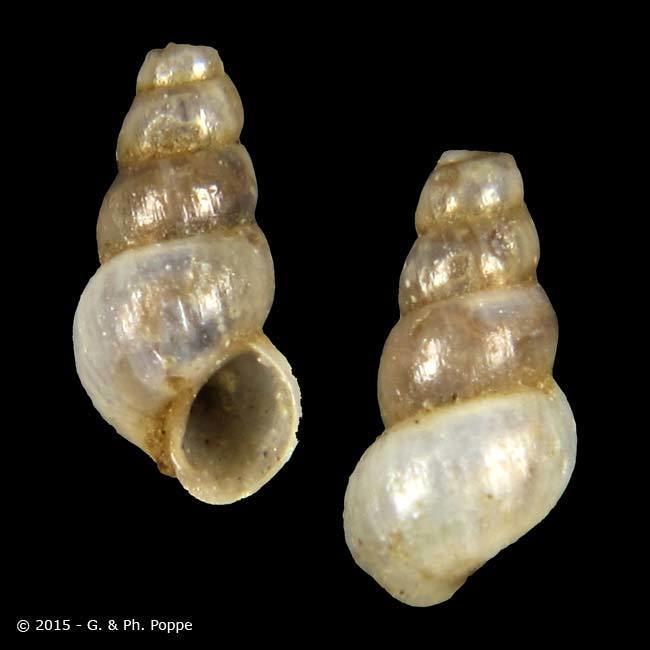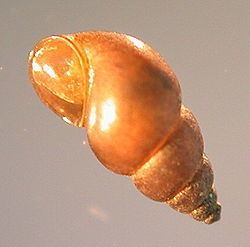Scientific name Hydrobiidae Higher classification Rissooidea | Rank Family | |
 | ||
Lower classifications New Zealand mud snail, Potamopyrgus, Hydrobia, Bythinella, Peringia ulvae | ||
Hydrobiidae, common name mud snails, is a large cosmopolitan taxonomic family of very small freshwater snails and brackish water snails that have an operculum, aquatic gastropod mollusks in the clade Littorinimorpha.
Contents

Distribution
There are over 260 species of Hydrobiidae living in Australia.
Description

These are very small or minute snails, with a shell height of less than 8 mm. The dextrally-coiled shells are smooth (except for growth lines conforming to the shape of the outer lip) and are usually rather nondescript. The shell offers very few robust characteristics to the systematist who is attempting to classify the species within this family. This difficulty is compounded by a high degree of intraspecific variation. Descriptions often have to be based on the characteristics of the operculum, radula and penis.
The shell of species within this family varies from planispiral to needle-shaped. The shell may have an open umbilicus or a plugged umbilicus. The thickness of the shell can vary from thin to fairly solid. The shell may be transparent and horn-colored, or colorless.
The number of whorls in the shell varies between two and eight. The shell can sometimes even assume a corkscrew or hornlike shape by loosening of the attachment of body whorl. The periostracum (outer layer of the shell) is usually thin, and is often colored. It can sometimes show hair-like projections.
The sinuous aperture is entire, not interrupted by a siphonal canal or other extensions. It is sometimes thickened. The protoconch is usually shaped like a dome, and usually shows a few spirals.
The corneous operculum is usually well-formed and shows only a few spirals.
The head, foot, mantle and visceral coil are colored pale gray to dark purple-black with melanin pigments. Subterranean species are often unpigmented.
The strong foot can be retracted into the shell. The mucous glands are situated at the anterior edge of the foot. There are no posterior mucous glands. The symmetrical cephalic tentacles are threadlike, with blunt or rounded tips. The eyes are located at the base of the tentacles.
The ctenidium (a comblike respiratory apparatus) goes along most of the length of the pallial cavity. This respiratory gill consists of 10 to 200 triangular filaments. The osphradium, the olfactory organ linked with the respiration organ, is usually relatively small.
The taenioglossate radula consists of more than fifty rows of teeth. The central tooth is trapezoidal. The lateral teeth have few to numerous cusps. The marginal teeth are usually with numerous cusps.
The species usually have both male and female individuals, but very rarely reproduction may be parthenogenic, caused by internal fertilization. The females lay eggs in single capsules on the leaves or stems of water plants. But sometimes they produce eggs that are hatched within the pallial gonoduct of the body, and in these cases the young are born alive. Species that inhabit estuaries sometimes produce veliger larvae.
The fossil record of this family extends back to the Early Carboniferous.
Habitat
Most species of this family live in freshwater (lakes, ponds, rivers, streams), but some are found in brackish water or at the borders between freshwater and brackish water. A few occur in marine environments on sandy or muddy bottoms between algae and sea grass.
Feeding habits
These small snails feed on algae, diatoms and detritus.
Taxonomy
This is the largest family within the superfamily Truncatelloidea. At one time or another some 400 genera have been assigned to this family, and probably more than 1,000 species. This family was originally named by Troschel in 1857, as the group Hydrobiae. Troschel was not certain of their rank, and he placed them in the Taenioglossata: Ctenobranchiata between the Lithoglyphi and Ancyloti. Over the years there have been numerous attempts to give an adequate and more finely divided classification. Thiele (1925, 1929 and 1931) set up the most comprehensive classification, with a review of the family at generic level.
Notable works about taxonomy of Hydrobiidae includes works by Radoman, for example Radoman (1983).
The classification, as specified by Kabat and Hershler (1993), does not form a monophyletic group, and was in need of revision.
A study by Wilke et al. (2001) using molecular data from COI (Cytochrome c oxidase subunit I) and 18S genes has resulted in a new tentative set of subfamilies: Hydrobiinae, Pseudamnicolinae, Nymphophilinae, Islamiinae and Horatiinae.
2005 taxonomy
The following subfamilies are recognized in the gastropod taxonomy of Bouchet & Rocroi from 2005:
The Amnicolidae and Cochliopidae are considered as distinct families according to the taxonomy of Bouchet & Rocroi (2005).
Genera
Genera in the family Hydrobiidae include:
Hydrobiinae
Belgrandiinae
Clenchiellinae
Islamiinae
Nymphophilinae
Pseudamnicolinae
Pyrgulinae
Tateinae
subfamily uncertain
subfamily ?
other generic names:
